Investing with Purpose: global capital investment plan
Plan articulating the important role private capital investment can play in driving an investment-led recovery. The plan focuses on sectors where Scotland can demonstrate a real international comparative advantage, and marks a pivot in our approach towards targeting ESG investment.
2. How Well Does Scotland do Currently in Attracting Global Capital Investment?
Scotland is an advanced economy and already benefits from significant flows of private capital investment, into businesses, infrastructure and real estate. However, the challenge in linking private investment to policy plans lies in turning the investment needs into genuine commercial opportunities. This chapter assesses the current flows, and the gaps in the market that Scotland would need to address in order to achieve this.
2.1 Current Investment Markets and Gaps in Scotland
In this section we consider in turn the current investment markets and gaps in Scotland across each of our three areas of focus – business investment, infrastructure investment and real estate investment.
2.1.1 Business Investment
Investment into Scottish businesses across all types of investment activity (angel, venture capital, private equity, mergers and acquisitions, IPOs) was around £34.8 billion in 2020.[10] Performance has held up during the pandemic – the value of investment increased by around 40% in 2020, though deal numbers were down by around 21% compared to 2019 (Figure 2.1).
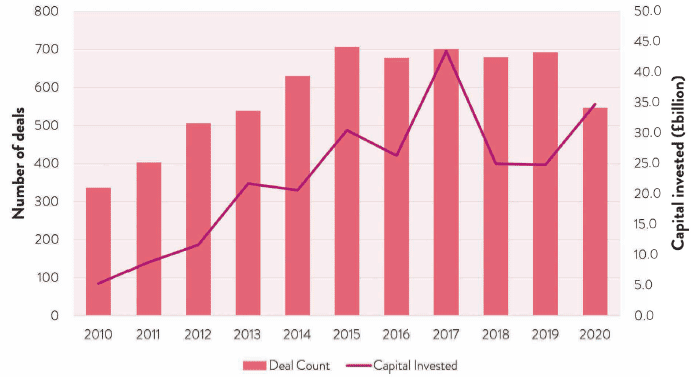
Source: Pitchbook. Figures covers all deal types.
Figure description:
Figure illustrates the levels of capital investment in Scotland’s enterprises between 2010 and 2020.
The broad measure used above is a good barometer of overall investment activity in Scotland across business growth, new assets, and in changes of ownership. A more targeted measure of investments into high growth businesses in Scotland is provided by looking at the 'risk capital' market. This risk capital measure includes only investment that is targeted at high growth and high potential businesses, and reflects to a lesser extent changes in ownership.
Scotland performs relatively well in the risk capital market (Figure 2.2). In 2019, Scotland recorded the highest number of deals on record (285 deals), an increase of 13% on the previous year. These deals were worth a combined £542 million in investment.[11] While the value of equity investment deals varies significantly by year, it is usually dependent on a few large investments. The value of the underlying market (in which 99% of deals took place) has grown steadily over time with a 12% increase in total investment between 2018 and 2019. Scottish investment is dominated by digital, IT and life sciences, accounting for half of Scottish deals in 2019 (Figure 2.3).
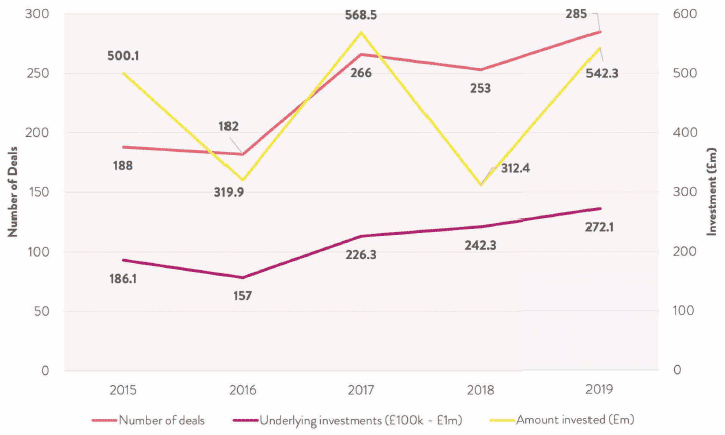
Source: Scottish Enterprise Risk Capital Market in Scotland (unpublished)
Figure description:
Figure illustrates the number of risk capital investment deals in Scotland and the amount invested in these deals between 2015 and 2019. Risk investment is defined as investment into high growth businesses specifically.
Scotland has a particularly strong angel investment market. High levels of angel activity are due to 'the Scottish model' of business angel syndicates investing alongside public sector funds. Scottish Enterprise (SE) works with companies with ambition to scale and those with potential to scale that are strategically important to our economy. SE catalyses investment into the early stage risk capital market by sharing the risks (and rewards) with investors. In 2019/20, this investment activity amounted to £76.2m, leveraging £272m of private sector investment, with over £75m from international investors.
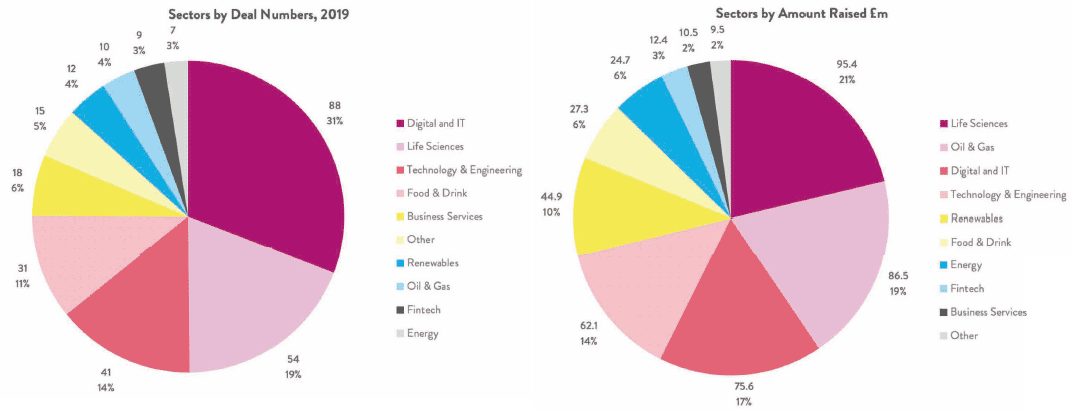
Source: Scottish Enterprise Risk Capital Market in Scotland (unpublished)
Figure description:
Figure illustrates the number of risk capital investment deals and amount invested in these deals by sector in 2019. Risk investment is defined as investment into high growth businesses specifically.
The UK's equity markets are highly concentrated in the 'golden triangle' of London and the South East of England which accounted for 72% of all deals, and 79% of all investment in 2018 whereas Scotland secured 7% of all UK deals but only 3% of value (Figure 2.4). This highlights that investment deals in Scotland tend to be lower on average compared to the UK average.
| Number of Deals | % of total deals | Value of deals (£m) | % of value | |
|---|---|---|---|---|
| London | 2002 | 52% | 5877 | 57% |
| South East | 483 | 12% | 1232 | 12% |
| East of England | 288 | 7% | 1078 | 10% |
| Scotland | 253 | 7% | 312 | 3% |
| North West | 188 | 5% | 348 | 3% |
| South West | 180 | 5% | 408 | 4% |
| West Midlands | 106 | 3% | 338 | 3% |
| Yorkshire and Humber | 105 | 3% | 222 | 2% |
| Wales | 88 | 2% | 105 | 1% |
| North East | 70 | 2% | 283 | 3% |
| East Midlands | 62 | 2% | 83 | 1% |
| Northern Ireland | 43 | 1% | 33 | 0% |
Source: Scottish Enterprise Investment Benchmarking Analysis (2019)
According to the Scale Up Institute, Scotland has a "structural finance gap" of around £0.6 billion for high growth businesses each year.[12] In addition to this structural gap, it is estimated that a UK-wide "cyclical" finance gap of around £7.5 billion has developed as a result of COVID-19, EU Exit and wider economic uncertainty.[13] These gaps in finance exist across different regions and nations of the UK across a broad range of sectors and asset classes as outlined in Figure 2.5.
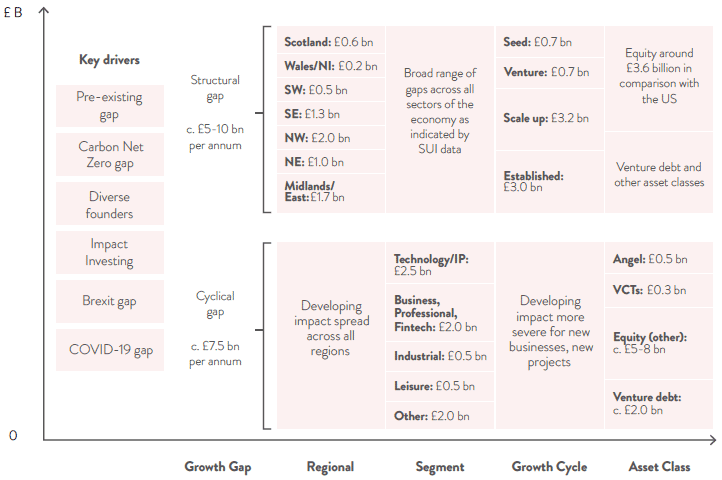
Source: Scale Up Institute (2020)
Figure description:
Figure illustrates the gap in business capital investment in the UK. It splits gaps between “structural” gaps that persist over time and “cyclical gaps” that appear during times of economic downturn. Breakdowns by UK region and sector are shown.
Two recent reports in this area are worth considering as to why Scotland's performance is at its current level. The Scottish Technology Ecosystem Review[14] (STER; also known as the Logan Review) provides analysis of the relative strengths and weaknesses of the Scottish investment market for early stage businesses. It argues that the Scottish equity market reflects the immaturity of the overall start-up ecosystem, observing that investment is dominated by an excellent angel investment network, and public sector initiatives such as SE's co-investment model. Whilst these funding mechanisms are well developed and have contributed to Scotland's growing reputation as a promising early stage hub, the report highlights that funding gaps remain for scaling companies pursuing Series A level (£10m+) funding rounds, and for early seed companies seeking investment smaller than the sums favoured by angel syndicates.
For early seed companies, the Logan Review suggests that the problem is chiefly one of discoverability and can be addressed through improved coordination to connect companies to individual investors. The gap in larger scale Series A investment is more complex, but can principally be explained by the absence of venture capital funds (VCs), both domestic and external, that are focused on scouting the Scottish ecosystem for deals. It is argued that in large part this is a problem of adequate deal flow. In developing ecosystems such as Scotland, there is a lower density of investable propositions meaning that VCs often consider their efforts better spent in larger ecosystems where many interesting prospects can be explored in a single day.
A key focus of the Logan Review is therefore to increase the volume of quality Scottish start-ups. Other challenges include the pitching expertise of start-ups, the prohibitive costs of regular travel to London to develop relationships with VCs and complex ownership models that include large numbers of passive angels and public sector investment, and are viewed as difficult to buy out. The Review recommends a range of solutions to these problems which are reflected in section 6 of this plan, reinforcing Ministers' earlier commitment to full implementation of the recommendations made in the Logan Review.
Benny Higgins' report on Financing Scotland's Recovery largely echoes the analysis presented in the Logan Review. It further highlights anecdotal evidence which suggests there may be a risk of Scottish companies relocating in order to access growth and scaling finance – that is, they leave at precisely the point when they would otherwise begin to generate significant economic and labour market benefits for Scotland. These two reports suggests a need to develop an investment-focused approach for all stages and ages of business maturity; and to broaden out the market in available funding for companies.
There is a recognition that there is not a one size fits all pathway for meeting investment needs for scaling companies. A more diverse, well balanced funding environment means that we are more likely to meet the needs of a greater range of businesses. Where we can meet these needs, companies will not only stay in Scotland, but we will be able to attract early stage businesses from other ecosystems, increasing the density of our innovative clusters. In practice, this is a significant shift in policy direction, from business-level (micro) intervention into a market-level (macro) intervention to ensure the effective functioning of the equity market for all business investment. Figure 2.6 highlights in more detail the differences between emerging ecosystems such as Scotland and more mature, 'post-tipping point' ecosystems.
| Characteristics of Mature Investment Markets | Characteristics of the Scottish Market |
|---|---|
| Mostly VC capital | Mostly angel capital |
| Full range of investments from small to very large | Mostly small investments |
| High discoverability of prospects i.e. VCs actively scout companies the ecosystem 'deal flow' | Poor discoverability of prospects – many companies have to go searching for VC. |
| Lower friction for investors: high volume of investable prospects on their doorstep. | Higher friction for investors – cap tables in Scotland are unusual and lower density of investable companies makes ecosystem less attractive for VC. |
| High pitching expertise among founders | Low pitching expertise among founders |
| Low-level of government funding | High-level of government funding |
Source: Scottish Technology Ecosystem Review (2020)
2.1.2 Infrastructure Investment
The Scottish Government recognises that public sector investment in infrastructure plays an important role in supporting resilience and enabling inclusive, Net Zero and sustainable economic growth. In 2018, we committed to a National Infrastructure Mission to increase annual public sector infrastructure investment by £1.5 billion annually. This will deliver total value of over £33 billion of public capital investment in the next five years.
Our recently published Capital Spending Review and Infrastructure Investment Plan set out the priority areas of spending to support our national outcomes, such as Health, Justice, Education, Housing, Transport and Digital. Our capital spending plans will be complemented by spending by UK Government in areas of reserved competence and by Local Authorities.
It is clear that public sector investment in infrastructure does not meet all investment requirements across all infrastructure classes, either because assets are in private ownership, or the responsibility lies with other administrations or is subject to UK regulation such as energy and communications networks. We must therefore consider how best to attract global capital into key sectors of Scotland's economy to complement our ambitious plans.
While establishing the size of the private infrastructure market can be difficult, estimates provided by the Investment Association suggest that its members managed around £45 billion in UK infrastructure assets in 2019, up from £35 billion in 2018.[15] The ONS estimate that private investment into constructing new UK economic infrastructure reached £10.3 billion in 2016, 68% of which (£7 billion) was accounted for by the energy industry.[16] This investment has also increased significantly over time (Figure 2.7).
Private investment into infrastructure in Scotland is dominated by investment in renewable technologies. Major investments include the £580 million Viking Offshore Wind Farm on Shetland and the £630 million subsea power cable connecting the island to the Scottish mainland. The forthcoming Scotwind round will add considerably to this, estimated to be as much as £8 billion.
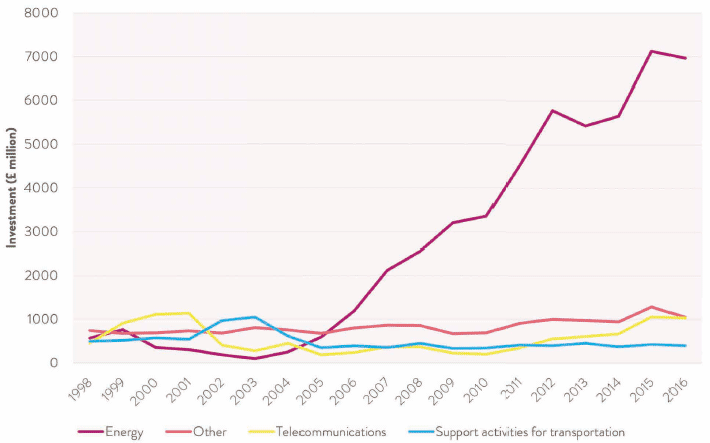
Source: Office of National Statistics. Note chart excludes sectors that are publicly funded in Scotland (such as water supply) which are publicly funded in Scotland.
Figure description:
Figure illustrates private market sector investment in infrastructure in the UK by sector between 1998 and 2016.
Mobilising significant private investment is crucial for transitioning to a low carbon economy and meeting our Net Zero commitments, and is crucial for delivering a Just Transition and meeting our challenging annual emissions targets. However, it is currently very concentrated in sectors where a combination of pricing certainty and regulation have been largely resolved. The dominance of private investment in wind, in particular, can be ascribed to UK-level regulatory interventions around Contract For Difference (CfD). CfDs incentivise investment in renewable energy by providing developers of projects which have high upfront costs and long lifetimes with direct protection from volatile wholesale prices, and they protect consumers from paying increased support costs when electricity prices are high.
Scotland's Investment Needs: A Just Transition and Digital Infrastructure
The transition to a Net Zero carbon emissions economy will require significant upfront investment in modernised infrastructure, capital projects, preserving and restoring Scotland's natural capital, and modernising our building stock. Petrol and diesel vehicles will be replaced with zero emission alternatives, buildings will be made more energy efficient and have their heat systems replaced, our renewable electricity generation capacity will significantly expand, our energy networks will be strengthened, and significant changes will occur in how we use our land.
Economic transformation on this scale will be challenging, but will create a wealth of new opportunities for businesses, investors and citizens. Seizing these opportunities will mean researching new technologies, but also developing innovative ways to bring them to market at scale. Many of these low-carbon technologies will have higher upfront investment costs than the technologies they replace, but the lower ongoing running costs and more efficient use of resources will provide a reliable source of returns.
Estimating the additional investment required to reach Net Zero is challenging, as many aspects of the transition pathway will depend on developments in technology, markets and international action beyond any reasonable forecast horizon. The UK's Climate Change Committee (CCC) has produced a range of indicative scenarios to try and address this, and estimate how much additional investment may be required to reach Net Zero, against a counterfactual of taking no further action against climate change. Under their central scenario, the CCC estimate Scotland will need to increase its investment to support the transition five-fold in real terms over the 2020s, from around £1 billion per annum this year to a steady state of around £5 billion by 2030.[17] While this estimate does not account for shifting investment from carbon-intensive industries, or for the savings generated by more efficient low-carbon alternatives, it provides an indication of the scale of the challenge and the direction of travel.
Rapidly ramping up investment in Net Zero over the 2020s will not only set Scotland on the path to ending our contribution to climate change, but will help establish leadership positions in key markets as the world moves towards decarbonisation.
We also know that significant investment is required to continue to develop our digital infrastructure. There is substantial commercial investment planned to develop full-fibre broadband and 5G networks – and the fibre being delivered through our R100 Programme which will also help extend high bandwidth connectivity services across rural Scotland – but some gaps remain in Scotland's digital services and infrastructure, notably the lack of international fibre connectivity and datacentres, both of which are key to maximising the economic impact of data-driven innovation that will increasingly drive the wider digital economy.
Analysis produced for the UK National Infrastructure Commission estimates that, over a 30 year period, building and maintaining a full-fibre network across the UK would cost £33.4 billion.[18] This investment is absolutely necessary for, at a minimum, keeping pace with other advanced economies, and this is only one area of priority infrastructure identified within our Infrastructure Investment Plan.
2.1.3 Real Estate Investment
In 2019, the commercial real estate market in Scotland was worth £1.99 billion (approximately 4% of UK market)[19] with almost all of it concentrated in Edinburgh, Glasgow and to a lesser extent Aberdeen. Office real estate accounted for the largest component (48%) of overall commercial real estate investment, followed by retail (28%). 'Alternatives' refers to non-traditional real estate investment such as student accommodation and hotels. Growth in commercial real estate has been broadly flat over recent years (Figure 2.8).
A significant proportion of this investment in Scotland is into 'standing stock', essentially ownership of existing assets changing hands. However, there may also be value-creating investment in standing stock through office refurbishment, for example. Whilst this is an important part of the funding market, without which risk and development capital cannot function, it is not the primary part of the investment cycle that drives other economic activity, e.g. in construction jobs or supply chain impacts. Between 2010-2019, Scotland attracted just 6.5% of the UK total for development investment, which is below our pro-rata share.
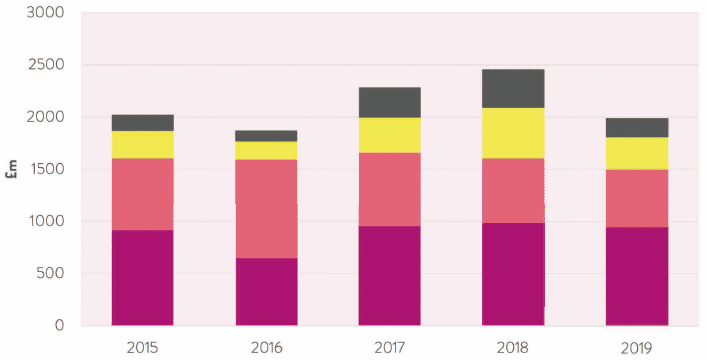
Source: CBRE
Figure description:
Figure illustrates the level of commercial real estate investment in Scotland between 2015 and 2019, split by type of real estate.
Scotland's (and the UK's) commercial real estate investment market has been heavily affected by the COVID-19 pandemic. Investment in Scottish commercial property dropped to £1.2 billion in 2020, down 42% from 2019 lockdown measures and economic uncertainty hit. More positively, through Scotland was the most popular UK destination for overseas investment outside London and the South East.[20]
It is not yet clear how recovery and transition will affect city and town centres, the underlying rent and return models in the UK, or the appetite for speculative and new developments. Other asset classes, including industrial and logistics, are more resilient, but there is no certainty that these will hold up; and without some government action, these may end up servicing consumer demand (essentially warehousing) without linking to broader economic opportunities and ultimately supporting higher value jobs.
Scotland also has an ageing industrial building stock which presents challenges from a physical, functional perspective and risks obsolescence.[21] Scotland requires a modern supply of industrial accommodation to cater for modern manufacturing practices in line with Industry 4.0, to serve our strategic opportunity growth areas and deliver sustainable inclusive economic growth aligned to our Net Zero ambition.
2.2 Structural Challenges in the Scottish Investment Market
While there are significant strengths in Scotland's economy, our market performance reflects some challenging underlying conditions: lack of diversity of actors, maturity and scale of markets, and the global lack of certainty around future direction.
Lack of demand shouldn't be under-estimated as a factor in explaining Scotland's investment landscape. Scotland has long-standing challenges around the structure, and more intangibly, the culture and growth ambitions of the business base. While Scotland is successful at encouraging early stage business growth, these businesses often lose momentum at later stages of the growth, limiting their potential.[22] More widely, Scottish SMEs are often reluctant to use finance to grow and expand. According to the Scottish SME Access to Finance Survey 2019, only around 2% of Scottish businesses use equity capital for growth, preferring otherwise to use self-funding or bank debt.[23] However, as noted in the 'Financing Scotland's Recovery' report, the tendency for businesses to use traditional debt may restrict growth in the future given the increased use of debt during the pandemic. The proportion of UK businesses using finance increased sharply during the pandemic from 28% in the three months to May 2020 to 40% in Q3.[24] Different forms of finance beyond traditional debt could help businesses restructure towards growth in future. Even seemingly small shifts in business views on the opportunities presented by different forms of finance would represent a significant shift from historical trends.
There is already significant work underway to stimulate demand for investment. Our enterprise agencies work with partners including Business Gateway, Scottish EDGE, accelerators, intermediaries and investors, and innovation centres to identify and support companies with scale-up potential. This includes entrepreneurship programmes, support to develop investible propositions, and direct investment. Lack of demand from businesses for private capital investment does, however, remain an issue.
Lack of demand is reflected also in infrastructure and property. The pool of developers and project promoters is relatively limited, compared to similar UK markets, and scale is often an issue for institutional investors or wealth funds, who regard the transaction costs of smaller deals as unattractive. The Scottish Government has put substantial effort into this, through initiatives like the Low Carbon Infrastructure Transition Fund that crowd in private investment, and latterly through the quality assurance processes around property and green investment portfolios. Scottish Futures Trust also collaborates closely with the Scottish Government, the wider public sector and the private sector to develop and deliver innovative financing mechanisms, many of which include a focus on attracting global capital. Nonetheless, lack of demand, diversity of players, and scale of projects remain issues to address in building a mature market.
This is likely to be all the more so on rolling out the technology to deal with climate change, where we also have co-ordination failure. This occurs where investment is needed in more than one element of a project to make any single element investable. An example of this is the relationship between the roll out of electric vehicle charging infrastructure network, renewable energy and electric vehicles. Coordination failure is also apparent in for example the combination of energy production, hydrogen and heating infrastructure. Public sector intervention is required to convene around most of the climate change related investment needs of the future. This is reflected in the sectoral plans being produced alongside our Climate Change Plan, and we will need to build investability and coordination into these from the beginning.
This in turn will require careful structuring of projects as the social costs and benefits of capital investment (e.g. supply chain or social impacts) may not be fully realised by the investor, and so will not be priced in to an investment decision. For example, a business producing renewable energy technologies may contribute towards reducing carbon emissions, or investment in digital infrastructure may create new technologies that help improve broadband access for local businesses and residents. One estimate puts the total social benefit of meeting Net Zero by 2050 at around £80 billion for the UK (through improved air quality, flood prevention and better health).[25] We will therefore need to consider market signals and mechanisms that encourage these benefits to be priced in, as well as considering the role of the public sector as a co-investor in projects that generate positive spill-overs.
Finally, in global terms Scotland is a relatively small market for capital investors and, as with other aspects of international trade, gravity matters. The further away from major centres of investment activity, the harder it is to overcome information asymmetry whereby companies and projects in Scotland are unaware of how to approach the market; and global market players are unaware of what Scotland might have to offer. Awareness raising, and more intelligent targeting of markets and investors, are required to help Scottish companies better engage with the larger investment hubs, but we also need to make more of our nearby markets – Edinburgh and London.
Public sector efforts to support investment in Scotland have shown individual successes. They have also been relatively fragmented, with the relevant skills spread across a number of directorates in Scottish Government, agencies and local authorities. That system itself is shifting with the launch of the Scottish National Investment Bank as both an investor and, over time, a centre of expertise for investment. There is much greater policy coordination, and enterprise agencies have undergone a process of focusing and democratising their business support to target companies and projects with the biggest economic and social impacts. We need to use the need for recovery and transition as a spur to coordinate, reprioritise and focus the work across the public sector. The intention is therefore for the actions proposed in this plan to be delivered jointly – in partnership across the public sector, with each organisation playing to its strengths, and in partnership with the private sector.
2.3 Maximising the Fit between Scotland's Investment Needs and Market Drivers
Marshalling an investment-led recovery is only partly about the clarity of what we need and want investment for. Alongside that, it requires us to understand and engage with what makes a project or business location viable in the eyes of the market, and monitoring changing market conditions and preferences.
This will not be a short-term project. Investment is constrained by uncertainty, and that uncertainty is currently being stimulated by the COVID-19 pandemic, by the UK's exit from the EU, and by the anticipation of further impacts from both. Under these circumstances, we must be realistic about timescales, and about the extent to which engaging with investment markets is the right solution for particular development and economic needs.
This plan shifts our approach from seeking investment in particular classes of assets - to creating functional, viable markets for all types of investment in Scotland, creating opportunities for projects and companies which do not need government support as well as for those that do. There are three main factors in this shift, which act as filters (Figure 2.9) – to answer the question 'is this the right project to engage the market on?'; and as levers – to assess how can we increase chances of success for prospects we do take to market.
These three factors are:
1. Increasing the opportunity for investment, by linking investment needs with the strongest areas of Scotland's international economy and certainty of future development.
2. Increasing viability of investments, supporting companies and projects become ready for market, and matching the incentives and regulation closely to the policy outcomes we want to achieve.
3. Increasing supply of capital, by better understanding and targeting different sources of funding.
In Chapter 3 we focus on the supply of private capital by reviewing the global investment landscape, the types of investors that exist, which ones we should increase engagement with, and what they are looking for. Chapter 4 focuses on increasing the opportunity and demand for capital, and the viability of projects, as we articulate Scotland's strengths – what we have to offer investors – and the types of investment we need to build our economy. In Chapter 5 we bring these together to identify the best fit between Supply, Demand and Viability – with a focus on five areas to guide our actions.
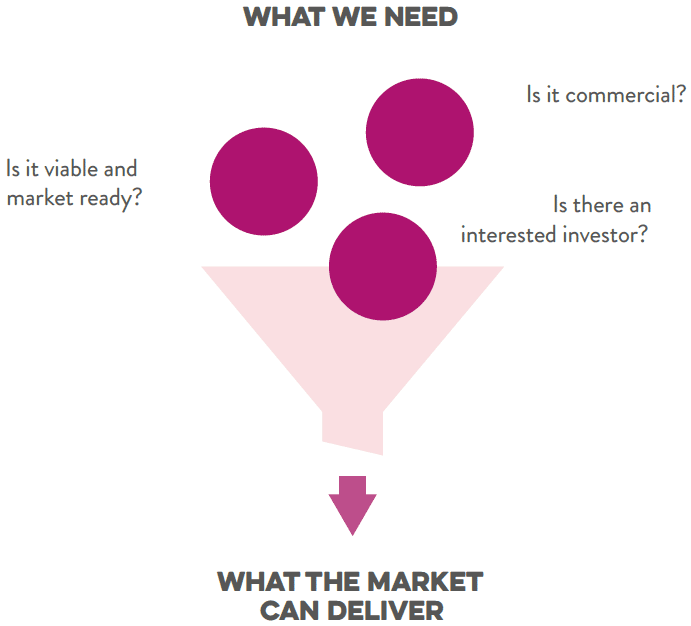
Figure description:
Figures illustrates the three main filters to assess the suitability of projects for presenting to market. The filters can also be used as levers to support the development of propositions in preparation for taking to market.
Contact
Email: investmentfinance@gov.scot
There is a problem
Thanks for your feedback